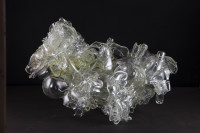
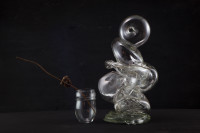
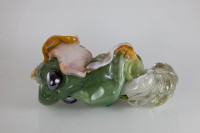
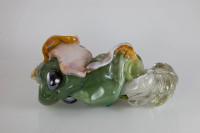












Per-René Larsen
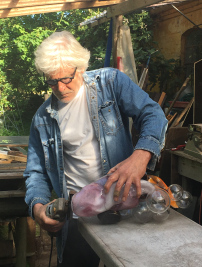
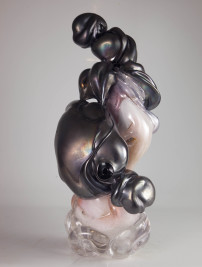
Per-René Larsen belongs to the first generation of studio glass artists in Denmark. He graduated from the School of Decorative Art (now Royal Danish Academy of Fine Arts, School of Design) in Copenhagen in 1975 and later attended the Nordic region’s leading glass school, Orrefors Glasskola (now the National School of Glass), in Sweden.
Per-René co-founded the ltd. glassworks Snoldelev Glasbrug Amba in cooperation with Skak Snitker and others and immediately became one of the leading studio glass artists. The experimental and explorative approach to the material has characterized Per-René’s glass art ever since.
In 1984 he founded the workshop ‘Fanefjord Glas’ on the Danish island of Møn, where he still works today. Here he pursues three tracks: utilitarian glass, which, in addition to paying the rent, is also a playful exploration of function; sculptural hot glass, often based on the concept of the vase; and Land Art installations, which investigate the optical possibilities of glass in a dialogue with the environment. All three lines of work are approached with equal care and skill.
Per-René never ceases to challenge conventions and has no desire to meet market expectations or ride the coat tails of artistic fads. His approach is that of a scientist studying the possibilities of his material, while the public aspects of the artist’s life are a necessary evil.
In a brief essay, ‘Why hot glass’, he outlines the considerations and challenges that exist at the intersection of art and craft, as follows:
A polarisation has arisen with studio glass. On the one hand are those who reject anything having to do with process-oriented work and who try to achieve artistic legitimacy by concentrating on the established language of art as expressed in sculpture, installation, etc. On the other hand are those who concentrate on pushing beyond the bounds of conventional craftsmanship in the name of purely aesthetic criteria, often without daring to infuse their works with the sharpness that could truly move barriers.
I see this polarisation as a misplaced focus on the context of the times – at its worst, a dishonest parrotry. An artistic statement cannot be inhibited by the fact that the world does not take the medium seriously. On the other hand, the process-oriented work can by virtue of respect and devotion to the material infuse a work with the physicality and poetry that modern art rejects, but which is a vital prerequisite for our mental survival.
About the glass series ‘Easy Living’:
The exhibition shows pieces from the series ‘Easy Living’ or ‘A paraphrase on tidying up accumulated matter’. The technique applied here is one that Per-René has developed over the past five years. Briefly put, the works are glass collages based on older pieces and details combined with specially produced glass elements entering into a new fusion and composition and emerging as a new work of art.
The result: a Per-René remix. The clear glass orbs are suggestive of utilitarian glass, and in combination with the older ‘vase’ components, the references to his earlier hot glass works are evident. In scale, the pieces resemble vases and classic craft objects traditionally used in the home. In addition to drawing on glass history the pieces also reference Per-René’s almost five-decades-long engagement with both utilitarian and sculptural glass. The collage technique is complicated. The process involves working directly in hot glass and requires painstaking planning. Regardless of the artist’s skill and experience the process can never be fully controlled, and throughout the artist has to remain open to the material and ready to follow the process as it unfolds.
By sampling both Per-René s history and the history of glass-making, the ‘Easy Living’ series offers a current take on contemporary glass sculpture. The material is pushed to the limit, the references are in place, and the result is startlingly beautiful and visually challenging.